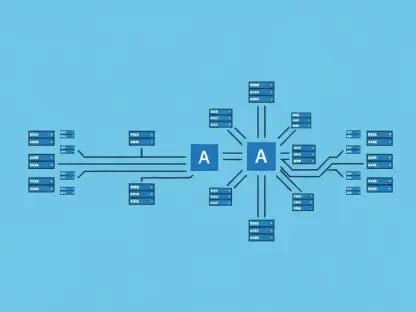In the dynamic realm of software development, threats are ever-present, lurking behind every digital corner. A sophisticated phishing campaign has recently targeted npm, a fundamental platform for managing JavaScript packages, putting developers on high alert. This campaign showcases the cunning approach of cybercriminals, employing typosquatting tactics to deceive unsuspecting users. The name npnjs.com closely resembles the authentic npmjs.com, cleverly designed to fool users into revealing sensitive information. This deceptive tactic is part of a larger trend targeting the open-source community, threatening both individual developers and the broader software ecosystem by potentially compromising millions of downstream projects.
Developers are finding themselves increasingly in the crosshairs of cyber attackers, who now utilize phishing tactics that are far more strategic and insidious than those of the past. The deployment of a fake domain, replete with a clone of the legitimate npm site, showcases the attackers’ intricate knowledge of the system. Offering a mirror-image login page, this clone aims to capture unsuspecting developer credentials. These campaigns are not just random attacks but are executed with precision, targeting prominent developers in the industry. The inclusion of personalized tokens within phishing emails indicates efforts to tailor these attacks, making them appear genuine and far more credible than traditional phishing attempts.
Understanding the Threat: Phishing Tactics and Implications
This campaign has managed to attract attention not only for its ingenuity but also for its semi-targeted approach, focusing on developers with significant reach and influence. By using personalized tokens, attackers are able to monitor user interaction and proceed with customized phishing flows that mirror npm’s legitimate processes. Such sophistication indicates an evolving landscape of cybercrime, demanding heightened vigilance from developers. Despite its skillful execution, the operation was ultimately flagged as spam due to tell-tale signs like its origin from a suspicious IP address known for malicious activities. This origin, coupled with email headers designed to evade standard authentication checks such as DMARC, DKIM, and SPF, reinforced its fraudulent nature.
As digital supply chain attacks increase in frequency and complexity, the potential impact on the development ecosystem becomes ever more profound. A successful infiltration of npm could lead to unauthorized access to maintainer accounts, resulting in the publication of malicious packages. Such exploits could reach millions of users globally and significantly disrupt the development and functioning of countless applications. Security analysts are urging developers to adopt advanced security measures, including two-factor authentication and regular updates to authentication tokens. These steps become essential components of a comprehensive strategy to combat and preempt these rapidly evolving threats.
Strengthening Defenses: Recommendations for Developers
Navigating this perilous landscape requires developers to treat any unsolicited login request with a healthy dose of skepticism. Given the increasingly sophisticated maneuvers of attackers, developers are advised to remain vigilant, ready to spot signs of phishing at first glance. Reporting any suspicious activities to organizational IT teams or security networks can play a crucial role in preventing widespread damage. The integration of security tools that can detect and block phishing attempts before they reach users is becoming invaluable. Additionally, fostering a culture of continuous security education and awareness can arm developers with the knowledge needed to identify emerging threats.
With phishing tactics growing ever more advanced, developers must stay ahead of cybercriminals by continually enhancing their cybersecurity strategies. Implementing security measures may require an initial investment of time and resources, but the long-term benefits of a secure development environment cannot be overstated. Encouraging open-source communities to engage in collective vigilance and collaboration in identifying threats can create a robust defense mechanism against potential intrusions. Such proactive measures are necessary steps in ensuring that developers can continue their vital work without constantly looking over their shoulders.
Conclusion: Future Challenges and Strategies
In the fast-paced world of software development, digital threats are a constant concern. A sophisticated phishing campaign has recently targeted npm, a key platform for managing JavaScript packages, setting developers on high alert. This campaign highlights the ingenious strategies of cybercriminals, who employ typosquatting tactics to trick unsuspecting users. By creating a deceptive domain name, npnjs.com, closely mimicking the genuine npmjs.com, attackers lure users into revealing private information. Such deceptive practices form part of a broader trend aimed at the open-source community, posing risks to both individual developers and the software ecosystem, impacting potentially millions of downstream projects.
Developers increasingly find themselves the focus of cyber threats, as attackers now employ more strategic and sly phishing methods. The creation of a counterfeit domain, complete with an imitation of the npm site, underscores the attackers’ deep understanding of the platform. Featuring a replica login page, this clone targets developer credentials. These campaigns aren’t random; they’re precise, targeting key figures in the industry and enhancing credibility through personalized tokens in phishing emails.









